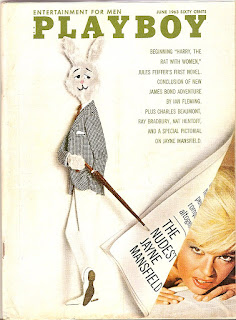From an early age she had dreams of stardom. To that end, she took ballroom dance lessons while studying the violin, the piano and the viola. She also excelled in school, particularly in mathematics. It was a very well-rounded education.
At 17, she married her first of three husbands, Paul Mansfield, whose name she'd carry throughout her career. Five months after the marriage, her first child, a daughter named Jayne Marie Mansfield, was born. At this point, she got serious about starting her career. The family moved to L.A. in 1954, where Jayne held a variety of odd jobs. She taught dance, did some part-time modeling, and even sold popcorn at the Stanley Warner Theatre. She also spent some time behind the camera, working as a photographer for actress Esther Williams.
 |
| The June 1963 issue. |
Having made a name for herself, Mansfield started landing film roles. Her earliest was a low-budget drama called Female Jungle, for which she'd earn a staggering $150. Here's the trailer. Bigger roles would follow.
The following year, Mansfield signed a six-year contract with Twentieth Century-Fox. The studio saw her as a replacement for Marilyn Monroe, who executives were finding more and more difficult to work with. Mansfield appeared in a number of films over the next few years, including The Girl Can't Help It (1956), The Wayward Bus (1957) and Will Success Spoil Rock Hunter? (1957). Click on each title to view the respective trailer.
To this blogger's incredible amazement, the demand for statuesque blonde bombshells started to decline in the early 1960s. The public had begun to tire of the unending publicity surrounding such notables as Mansfield, Marilyn Monroe and Bettie Page. As a result, Mansfield's Hollywood career started to decline, and the studio loaned her out to foreign productions. Her biggest hit during this era was Too Hot to Handle, produced in Great Britain in 1960.
A few years later, Hollywood execs wised up, and offered her a starring role in the Dean Martin film Kiss Me, Stupid. Mansfield turned it down however, as she was pregnant with future Law and Order actress Mariska Hargitay, a product of her second marriage to Hungarian actor Mickey Hargitay. Mansfield's final film role was in 1967's A Guide for the Married Man, which starred Walter Matthau.
Mansfield had also developed a nightclub routine for which she was frequently on the road. On June 29, 1967, she left an engagement in Biloxi, Mississippi headed for New Orleans. She was accompanied by her attorney Sam Brody and driver Ronnie Harrison, who all rode up front in the 1966 Buick Electra. In the back seat, three of her children (including Mariska) were peacefully asleep.
As the car approached Slidell, Louisiana, it was engulfed in a heavy fog, the result of insecticide spraying that made visibility nearly impossible. Harrison didn't slow down in time, and the car drove into the rear of a tractor trailer. All three adults were killed, while thankfully, the children were unharmed.
A popular urban legend contends that Mansfield was decapitated in the accident, after a photograph was published showing blonde hair entangled in the smashed windshield. This is untrue however, verified through her official death certificate, which lists the cause of death as a crushed skull with avulsion of cranium and brain.
She was interred at Fairview Cemetery in Pen Argyl, Pennsylvania. The inscription reads "We live to love you more each day," a famous Mansfield quote.
Normally, I'll offer directions on finding the grave, but this one sticks out like a sore thumb. It's a very small park and you won't have any trouble spotting her distinctive headstone.
Rest in peace, Gorgeous.
Trivia
- Although she's buried in her home town in Pennsylvania, Hollywood hasn't forgotten her either. A cenotaph in her honor was placed at Hollywood Forever, the cemetery where many stars are laid to rest. It bears the same inscription as her headstone in Pennsylvania.
- Mansfield's death car is on permanent display at the Dearly Departed Museum in Los Angeles. Although I've taken the tour myself, photography is not usually allowed. You can see it in this video however, posted by vlogger Jordan the Lion. The car comes in at the 7-minute mark.
- Mansfield's death would bring change to the automotive industry, after the National Highway Transportation Safety Administration recommended the placement of an underride guard on all tractor trailers to prevent similar accidents in the future. Today, it is often referred to as the Mansfield Bar.
- Several musicians have recorded tribute songs to Mansfield. These include "The Ballad of Jayne" by L.A. Guns and "Kiss Them For Me" by Siouxsie and the Banshees (the title is a reference to a 1957 Mansfield film). Click on the titles and give them a listen.
- While studying Dramatics at the University of Texas at Austin, Mansfield joined a campus theatrical society called The Curtain Club. Other members included comedian Rip Torn, crooner Tom Jones and character actor Pat Hingle.
- Early in her career, Mansfield lost a modeling gig for General Electric, as the company feared her breasts were "too prominent."
- In 1965, Mansfield released two songs with Jimi Hendrix backing her on guitar, "As the Clouds Drift By" and "Suey." Give them a listen.
- While Mansfield portrayed the image of the "dumb blonde," she was anything but. She boasted an I.Q. of 163 and spoke five different languages. She often complained that the public didn't care about her brains, saying "it's not the 163, its the 40-21-35."





No comments:
Post a Comment